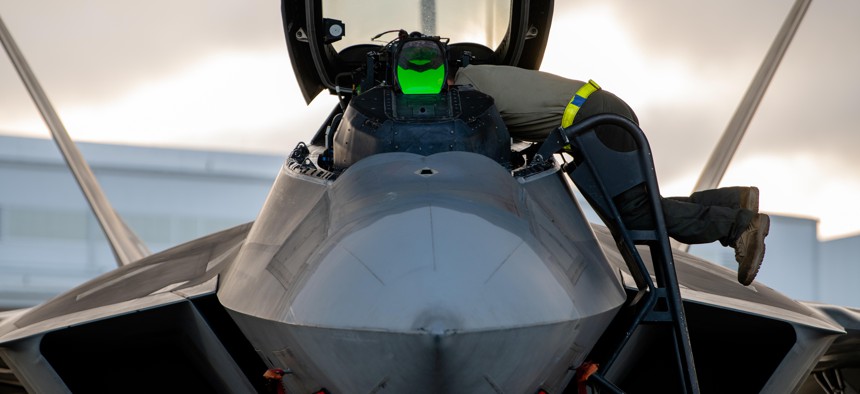
Airman 1st Class Quifer Von examines an Air Force 325th Fighter Wing F-22 Raptor prior to night flight training at Eglin Air Force Base, Fla., March 1, 2023. U.S. Air Force / Airman 1st Class Zachary Nordheim
How Lockheed is positioning the F-22 to fly into the 2040s
The Pentagon is spending billions to keep the Raptor ready for battle.
DAYTON, Ohio—Lockheed Martin officials say they can support the F-22 as long as the Air Force wants to fly it, even if that’s a decade longer than currently planned.
“There's no limitation on the airplane itself that drives it. That will be a decision in terms of force management and how soon any replacements or other technologies might come along, so we're posturing beyond seven years,” OJ Sanchez, vice president of Lockheed’s F-16 and F-22 programs, told Defense One on Tuesday. “We're continuing to think, ‘How do we keep the airplane relevant?’”
Military aircraft tend to stick around longer than expected, Sanchez said, mentioning the F-16—a program that opened a new production line in 2021 for foreign military sales three years after the original line closed. While various allies have expressed interest in buying F-22s, U.S. law prohibits the export of the jet.
“It’s less about how long is it going to be in service and more about the unique capability that it brings to ensure air superiority, wherever it's needed…so the Air Force has asked us to move forward with that modernization program, and then we'll see how long the aircraft endures,” Sanchez said.
The Air Force has signaled its desire to begin retiring its entire fleet of F-22s as soon as 2030. The service has already asked to shed 32 older F-22s in its 2024 budget—a divestment that was blocked by Congress last year.
But despite potential retirements, the service is heavily investing in upgrades for the Raptor. The Pentagon awarded Lockheed a $10.9 billion contract in 2021 to modernize the fleet.
More than 80 Raptors have had some type of modifications already, Sanchez said, and Lockheed is planning to complete more than 100 total F-22 modifications this year.
While some of the modifications are classified, Sanchez said a big part of the effort is moving toward an open systems architecture through a series of upgrades called Raptor Agile Capability Release, or RACR.
“Every year or so, we're changing the software, and in some cases the hardware, that supports that ongoing modernization to kind of meet [Air Combat Commander] Gen. [Mark] Kelly's edict: how do we make the airplane do more, go farther, see farther,” he said.
Lockheed finished a new weapons installation this year, called 3.2B, Sanchez said, which added new air-to-air weapons to the fighter—AIM-9X and AIM-120D.
The company is also adding hardware—external low drag tanks and pylons—to the jet so it can hold more gas when it’s refueled, giving it more range and the ability to go farther or stay on station longer, he said.
While the Air Force could start divesting F-22s soon, the Raptor still needs to be upgraded to address today’s threats, Brig. Gen. Dale White, program executive officer for fighters and advanced aircraft, told reporters Tuesday. The service is also applying lessons from the program to its new fighter jet, called Next Generation Air Dominance, or NGAD, White said.
The Raptor will eventually be replaced by NGAD, which the service will award a contract for next year. Lockheed and Boeing are believed to be designing a fighter for the NGAD program, while Northrop Grumman announced last week it will not bid on the program.
“We still have a threat we have to address now. The F-22 represents our ability to address that threat, able to be the bridge to NGAD, and in order to do that, we have to keep it modernized. We have to keep it legal and operationally viable,” White said.
The F-22 is known for its stealth technology, Sanchez said, which will be a “mission thread” they will pull into the company’s next-gen programs.
“They're state-of-the-art things that we're doing on Raptor that we hope—we won't be the ones that decide that—but we hope will have applicability to drive the mission threads further in the next-generation technology,” Sanchez said.
Originally built to battle Russian warplanes, the F-22 is a fifth-generation stealth fighter that’s considered to be one of the best air-to-air combat jets. The Pentagon operates F-22s around the world, and recently sent jets to the Middle East to stop Russian harassment in the region. The fighter also made headlines when it shot down a Chinese surveillance balloon in February. Decades ago, the Air Force envisioned a fleet of 750 Raptors, but the fleet was capped at just 187 jets due to cost overruns. Lockheed delivered the final F-22 to the Air Force in 2012.





